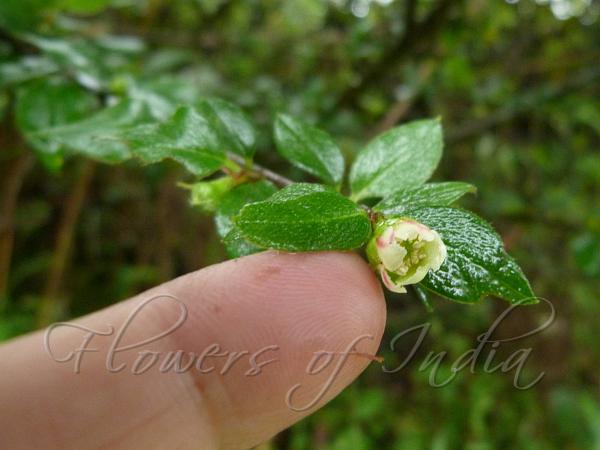|
| Closed-Flower Cotoneaster |
|

|

| File size | 248976 |
| Original date | 6/21/13 9:24 AM |
| Resolution | 1536 x 1152 |
| Flash | Flash did not fire, auto |
| Focal length | 4.5mm |
| Exposure time | 1/60s |
| Aperture | 2.8 |
| Focus Distance | |
| Metering Mode | Multi-segment |
| Camera make | Panasonic |
| Camera model | DMC-FZ40 |
| Sensor type | OneChipColorArea |
|
|
|
|
Photo: |
Botanical name: Cotoneaster acuminatus Family: Rosaceae (Rose family)
Synonyms: Cotoneaster nepalensis, Cotoneaster mucronatus
Synonyms: Cotoneaster nepalensis, Cotoneaster mucronatus
Closed-Flower Cotoneaster is a deciduous erect shrub, 2-3 m
tall. Flowers are borme in cymes 1-2 cm, 1-3 flowered; rachis and stalks
yellowish hairy, bracts lanceshaped or
linear, 2-4 mm. Flower-stalks are 3-5 mm. Flowers 6-8 mm in diameter.
The cup below the flower is bell-shaped. Sepals are triangular, 1.5-2.5
x 2-3 mm, tip pointed. Flowers do not open fully - petals are erect,
pink or whitish, ovate to
obovate, 3-4 mm and nearly as broad, hairless, base clawed, tip blunt
or erose. Stamens are 20, shorter than petals.
Branchlets are grayish brown to brownish, round, initially
densely yellowish hairy, hairless when old. Leaf-stalks are 3–5 mm,
hairy, stipules partly falling off at fruiting, lanceolate, 3-5 mm.
Leaves are elliptic-ovate to ovate-lanceshaped, 2-6.5 x 2-3 cm, both
surfaces hairy, more densely so below, base broadly wedge-shaped, tip
long-pointed, rarely pointed.
Fruit is a bright red
berry, ellipsoid, 8-10 x 7-8 mm. Closed-Flower Cotoneaster is found in the
Himalayas, from Kumaun to Bhutan, Tibet, W. China, ataltitudes of
2500-3700 m; Flowering: May-June.
| Identification credit: Nongthombam Ullysess | Photographed in Tawang, Arunachal Pradesh. |
• Is this flower misidentified? If yes,